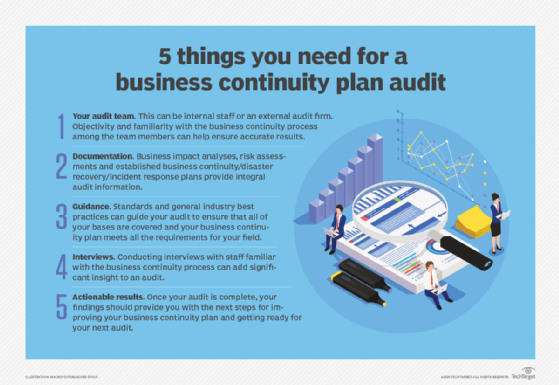
What is a business continuity plan audit and how do you create one?
A business continuity plan audit is a formalized method for evaluating how business continuity processes are being managed. The goal of an audit is to determine whether the plan is effective and in line with the organization's objectives.
A business continuity plan (BCP) audit can be performed internally or with the assistance of a third-party audit firm. Audit objectivity is critical to reviewing and updating the plan, so an outside firm might seem preferable, but an internal audit team offers a deeper familiarity with the business continuity planning process. The organization must determine whether an internal or external audit is the right choice.
A BCP audit should support corporate resiliency efforts and critical business functions. An internal BCP audit defines the risks or threats to the success of the plan and tests the controls in place to determine if those risks are acceptable. An audit should also quantify the effects of the plan's weaknesses and offer recommendations for business continuity plan improvements.
Business continuity plan audits benefit from a structured audit framework such as those outlined in the British Standards Institution's BS 25999 or the International Organization of Standardization's ISO 22301:2019. Auditing a business continuity plan and its documentation against an established benchmark ensures it's consistent with industry practices and controls.
BCP audit objectives
The primary objectives of a business continuity plan are to limit downtime during a business interruption, protect personnel in the event of a disaster, minimize financial losses due to a disruptive incident, and restore critical business functions and infrastructure following an incident.
With a BCP audit, the main goal is to ensure the plan can accomplish these critical tasks. Corporate resiliency efforts vary, based on the organization's objectives and requirements, so the audit team must take those requirements into account. However, there are some general goals to aim for with an audit.
A BCP audit should validate an organization's business continuity plan and ensure all moving parts work correctly. An audit should examine the performance of activities in the plan and ensure the business continuity and disaster recovery (BCDR) processes meet organizational standards. It should also call attention to any maintenance or updates that should be performed if there are any clear gaps.
What information gets audited in a BCP?
Many items within a BCP fall within the audit scope and require careful scrutiny. The organization must review its plan's risk management effectiveness and capacity to sustain critical business processes, including the following:
- Governance. Does the BCP adequately define roles and responsibilities for its execution?
- Risk management. Does the BCP address all relevant risks? Is the business impact analysis (BIA) thorough? Are all vulnerabilities accounted for in the plan?
- Recovery strategy. Is documentation included for prioritizing and preserving critical business processes? Are data protection and recovery processes articulated? Is the impact of disruptions to third-party relationships and dependencies covered?
- Communications. Are protocols for communication with stakeholders covered? Are escalation paths defined? Is communication with customers and the public a concern, and if so, how is it addressed?
- Compliance. Must the BCP adhere to specific industry standards, such as ISO 22301:2019 or those from the National Institute of Standards and Technology, and if so, does it? Has a gap analysis been performed?
- Training. In pursuit of full preparedness, have relevant employees and managers been trained in their role in disruption recovery? Are the crisis management decision-makers familiar with the BCP?
Benefits of a BCP audit
Although an organization can try to mitigate and avoid potential risks, the size and scope of potential threats such as cyberattacks and natural disasters are often unpredictable. The more preparation and planning an organization can do, the better. Business continuity management efforts are bolstered by performing an audit, which gives feedback as to what is working in the plan and what needs improvement.
A comprehensive BCP audit provides objective feedback that can improve a business continuity plan with actionable changes and updates. A thorough audit can determine a plan's sufficiency and success by reviewing it against general industry best practices and management expectations.
When it comes to BCDR, a general rule is the more testing, the better. Technology and threats are constantly changing, and auditing a business continuity plan is one more step to ensuring the plan is up to date and won't fail when faced with disaster.
Considerations for a BCP audit
There are some key elements to consider with a BCP audit, including the following:
- Scope. Does your audit cover both business continuity and disaster recovery plans? Are all mission-critical systems covered in the plan, or will only specific systems be checked? Ideally, a BCP involves all aspects of an organization, even its reputation. However, it's likely that with most organizations, certain areas take precedence depending on the industry or threats that have the biggest effect. Know what the business continuity plan encompasses and covers when preparing an audit.
- Management. In addition to knowing who is involved in the business continuity plan, ensure roles and responsibilities are clearly defined. Who is accountable for the plan's success or failure? Who needs to be involved with developing, training and testing? This is an area that an organization should periodically revisit, as responsibilities can change over time.
- Accuracy. When performing an audit, the team should be clear about the requirements of the business continuity plan. Reports such as a BIA and risk assessment should be up to date and on hand. If the plan must meet any compliance standards, those parameters must be included in the audit. Along with accuracy, BCP audit objectivity is critical. The audit must present unbiased results, especially if it's performed internally.
- Maintenance. Business continuity planning isn't a one-and-done procedure; it's an ongoing process. The business continuity plan -- and by association, the BCP audit -- must be updated as frequently as the organization undergoes changes. Annual updating might be necessary for some organizations, but frequency can differ. If the company changes hardware, software, staffing or location, these can all affect a business continuity plan. To maintain the integrity of the plan and the audit, they must be updated regularly to reflect changes.
- Confidentiality. Although it's important to keep required personnel informed about BCDR planning, company vulnerabilities shouldn't be made readily available outside the organization. As cyberattacks increase and information security has become a critical concern, the results of a BCP audit should be adequately protected.

Creating a BCP audit
A business continuity plan audit can be as simple or as complex as an organization wants it to be. The following 10 steps can serve as a solid starting point for building a business continuity plan audit suited to a specific organization:
- Prepare the audit plan. This includes outlining the scope, approach and schedule of the BCP audit.
- Review and summarize documentation information for the audit, such as BCDR plans, BIAs, risk assessments and emergency communications plans. If gaps in this documentation exist, update the information as needed.
- Review and apply relevant standards, regulations, legislation and good practice documents to validate preliminary findings and prepare audit paperwork.
- Identify audit controls and prepare work papers that reflect established business continuity metrics defined by standards groups, regulators and legislators.
- Conduct business continuity audit interviews with relevant personnel across the organization.
- Following audit interviews and discovery, prepare a draft audit opinion report for discussion with the organization's interested parties.
- Complete a final audit report and communicate the findings to relevant personnel. These findings can include interview results, documentation notes and recommended actions to improve the business continuity plan.
- Complete an action plan and time frame to remediate the BCP according to audit findings.
- Ensure the action plan is implemented within the set time frame.
- Schedule the next BCP audit.
Learn what business continuity certifications are offered to IT professionals to help ensure they have the skills and knowledge organizations need to continue operations in the event of a disaster.






